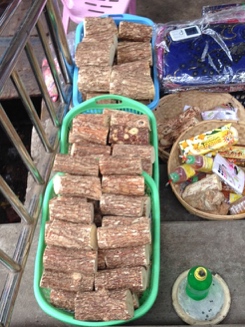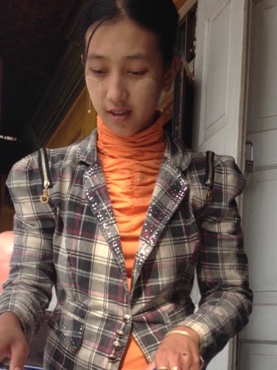“When I die I will be a Burman … and I will always walk about with a pretty almond-coloured girl who shall laugh and jest too, as a young maiden ought. She shall not pull a sari over her head when a man looks at her and glare suggestively from behind it, nor shall she tramp behind me when I walk: for these are the customs of India. She shall look all the world between the eyes, in honesty and good fellowship, and I will teach her not to defile her pretty mouth with chopped tobacco in a cabbage leaf, but to inhale good cigarettes of Egypt’s best brand. ” — Rudyard Kipling, “Mandalay”
Myanmar, formerly Burma, is a country full of contradictions. Full of Buddhists, the country actually has a small minorities of Muslims, who are denied citizenship if they cannot prove their ancestors were in Burma before 1823. The buildings in the capital city look as if they desperately need a wash and a paint job, while office buildings rent to NGOs and businesses for exorbitant rates such as $25,000 a month, increased from $4,000 a month just two years ago (click here for an article about the $90,000 monthly rent paid by UNICEF). The train station, a glorious architectural gem built in 1877 by the British, looks ready to fall down- a 620 km train ride from Yangon to Bagan takes a stated 16 hours (more likely to be 20), while the bus ride takes only 8.


From Bangkok, it was a simple matter of applying online for a Myanmar visa, and booking a cheap flight to Ÿangon on Air Asia. The flight was 90 minutes long, and we were met at the airport by a taxi driver sent by our friend Maia, whom we had worked with in Sudan. While visiting her in Ÿangon, we went to the Shwedagon Pagoda, a wonderful Buddhist Shrine that, according to local legend, began in 600 BC, and was continually enlarged by a succession of kings to its present height of 99 meters. (Historians and archaeologists say it was more likely built between 600 and 900 AD. One of the difficulties of researching Myanmar history is a lack of many written historical accounts). We found the pagoda to be quite beautiful and a nice place to walk around and people watch, particularly all the monks and nuns (shaved heads all around). It’s very peaceful up there, away from the cars and traffic, and you can just sit and listen to the tinkling sound of the tiny brass bells atop each stupa.

We visited the National Museum, but unfortunately you can’t take photos there. I don’t know why many developing nations won’t let you take photos. The museum was interesting, with a huge array of artifacts and cultural information. Definitely worth a visit.
We do a lot of walking around cities, just looking at the buildings, the parks, the people. One of our favorite pastimes is to try street food or settle for a while at an alley cafe and watch the world go by. It’s a good way to chat with some locals and try new foods. Sometimes we’re pleasantly surprised, and other times we’re not.

Before we left Yangon, we walked by Aung San Suu Kyi’s house, where she was held under house arrest for several years, opposing the government. She has now been released and is head of the National League of Democracy.

Rather than the scenic but very grimy and outdated train, we opted for the bus to Bagan, a northern plains area covered by literally three thousand stupas, temples, and shrines. We took a night bus and arrived at 5 am, so we decided to walk to the “archaeological zone” and watch the sun rise. In less than half an hour, we could start to see the faint outlines of temples…. And then the sun began to rise and we could see dozens. We began to hear a whooshing noise, and slowly a hot air balloon rose above the trees and temples….and then a dozen more. As we walked, we lost count of the temples. We walked all over the area, including down to the banks of the Irrawaddy River, and just marveled. Eventually we wandered back to town, got some lunch, and took a nap. We got up at four and went back out to watch the sun set behind some other temples. Bagan, and other cities in Myanmar, has that acrid smell from burning trash and controlled-burning cultivation techniques. I remember Sudan and Egypt had the same smell. It’s not terrible, as long as it’s at a distance.

We stayed in Bagan for two days, walking around and bicycling around, and trying different restaurants. Then we bought a bus ticket to head east, to the area around Lake Inle. Our bus turned out to be a minivan, and we were the only passengers. Weird. The ride was interesting, though, passing through villages, crossing a few rivers, and going over a small mountain range. Eventually- at 4:30 even though the driver said we would arrive at 2- we arrived in Nuangshwe, a small town on the edge of Lake Inle. We found a hotel for $25 with hot water, wifi (semi), and breakfast, and then walked around town for a bit. Like Bagan, the town consists of four paved roads, in a grid, with maybe six more dirt roads making up the entire main center of action. There’s probably a dozen small hotels/guesthouses here, a dozen restaurants, and a dozen tour services shops, helping travelers to organize boat rides, trekking, bus tickets, share taxis, bicycle rentals, or air tickets. It’s impossible to get lost and you really don’t need a map.

On the western end of town is a canal, which feeds into the lake. Perhaps fifty boatmen await, hoping to entice you with a boat tour of the lake and the Shan and Karen villages that border it. They have very long- 15 meter- boats that are very narrow, and very shallow, because the lake is an average of three feet deep. We negotiated a boat tour on our second day in town, and off we went to the southern end of the lake, 20 miles away. We visited a lovely pagoda site, rising up from the banks of the lake like a Disney castle, and then boated through a floating village, the houses all set up on stilts with their canoes parked underneath. We passed men catching fish, and women harvesting rice or washing laundry in the lake. We even saw a woman hanging strands of rice noodles in the sun to dry. We visited a Shan village to see a pottery worker, and got to try our hand at a candle holder and a vase. We also visited a boat building yard, where it takes four men one month to build the 15 meter boats by hand. We visited a cheroot rolling house, made with tobacco, cloves, honey, tamarind, and rice wine. And we saw a weaving workshop, where they made thread out of cotton, silk, and lotus stems to make clothing and scarves. The lotus stem part really blew me away- a very painstaking process. Those scarves are very expensive. If you’ve ever seen pictures of traditionally dressed Myanmar women, the way they wear their scarves wrapped around their heads show which tribe they belong to. The men all wear the longyii, which is a long piece of fabric around their waist, tied like a wrap around skirt. In the villages they wear the Burmese conical woven hats, but not in the city.

The boat driver wanted to take us to the “long neck village”, but I declined. I do not want to pay tourist dollars to continue the exploitation of the young girls. If they take the rings off their necks they cannot even hold their heads up. And now they do it for tourist dollars, even busing them into Thailand and China to display.
Also near the lake is a winery, one of two in Myanmar. We walked out to the vineyards and tried four of their wines, enjoying the views from their hilltop of the small villages nearby. A nice way to spend our last afternoon in Naungshwe. We left that evening on a night bus, arriving in Mandalay in the morning.

In Mandalay, there wasn’t a whole lot to do. There’s an ancient walled Grand Palace, but it was destroyed in World War II, and rebuilt with forced labor and new materials, rather than the original teakwood. So instead we climbed Mandalay Hill, just outside of town, where you pass through pagodas, shrines, and temples as you ascend the hill. Really nice views from the top, as well. And at the bottom, we visited the Kuthodow Pagoda, which claims to be the largest book in the world, consisting of 1774 stupas, each one holding an inscribed tablet of the Tripitaka, a sacred Buddhist text.


Uniquely Myanmar:
*Tea leaf salad. Now my favorite dish in Myanmar.

* The women in Myanmar all decorate their faces with a yellow paste made from tree bark. They wear this as decoration, and as sunscreen. It takes a little getting used to, but now I think it’s very pretty.


* There are no bicycles, scooters, or motorcycles allowed in Yangon. Very rare for an Asian city. No one is quite sure why they are illegal in that one city.
* The fishermen on lake Inle have developed a unique way of paddling. They stand on one leg in the prow of their boats, and wrap their other leg around their paddle. They use that leg to steer and push themselves forwards, while keeping their hands free for their nets.


So interesting! Do you use yellow face paint for sunscreen , too?
LikeLike